CMST110-07 Midterm
1/135
Earn XP
Description and Tags
Name | Mastery | Learn | Test | Matching | Spaced |
|---|
No study sessions yet.
136 Terms
Anna May Wong (1905-1961)
chinese movie star, first chinese american movie star
victim of ORIENTALISM -- stereotypical representation of Asians through a colonialist attitude
she was simultaneously both typecasted and passed over in favor of non-asian actresses
fragmentation of a mass audience
"mass" audiences don't typically turn up anymore
shift from "broadcasting" to "narrowcasting"
how was the mass audience fragmented
began in radio -- stations
spread to cable -- channels
overtakes network TV -- streaming
social media
Raymond Williams (1921-88)
coined the “structure of feeling” and “ways of being in the world”
culture is composed of patterns of artifacts & behaviors, selected generation by generation, which produce shared ways of being in the world & structures of feeling
Raymond Williams definition of culture
Culture is "a whole way of life".
Culture is "ordinary".
Raymond Williams on the perceived types of culture
High culture
Pop culture
Material Culture
Lived Culture
Dominant culture people want to be apart of the dominant culture which may be high culture
3 key terms from cultural analysis
physical/material
social/ritualistic
attitudinal
physical/material
physical objects are artifacts
social/ritualistic
family, friends, nation
attitudinal
a way of being in the world
high culture
the cultural patterns of a society's elite
low (pop) culture
the cultural patterns of the "masses"
the difference between high culture and low culture
THERE IS NONE. HIGH CULTURE DOESN'T EXIST. all culture is valuable and the idea of high vs. low is a problematic concept
pre-print europe
literature/records were produced by hand -- manuscripts
access was exclusive to the elite -- knowledge was limited
manuscripts
hand-written copies of old documents
problems with manuscripts
takes weeks or months to produce one
production is limited almost entirely to monasteries
monks drink wine
one accident with a candle can send them up in flames
errors in copying are everywhere
viewed with skepticism
starting nature of printing press
increased production of content
decreased production time
developed economy of scale based on rapid production + low unit price
print replaced hand-produced books in only 50 years
defused thru-out europe between 1450-1500
facilitated the european rennaissance, ushered in modern age
impact of print tech on power
undercut the power of elites and offered knowledge to masses
set the stage for Enlightenment + Scientific Revolution
set the stage for Capitalism
set the stage for European colonialism
set the stage for Protestant Reformation
Changed relationship between STUDENTS + TEACHERS
impact of print tech on stylistics
competition among printers forced innovation
brought us chapters, indexes, illustrations
print shops
intellectual collaboration among experts
merchants and scholars figure out ways to finance the production and distribution of big projects: theology, law, and medicine
Scholars determine the most reliable copies of ancient manuscripts to print
functions like a combination sweat shop, boarding house, saloon, and research institution
printers are among the first capitalists
investment syndicates develop -- financing labor & supplies
printers form international distribution networks thru europe
sales reps ("travelers") market books
print tech reorganized the nature of knowledge
editors become gatekeepers who pass judgment on content
scholars are able to integrate and unify entire bodies of knowledge for the first time in human experience
increased output encouraged new combinations of old knowledge and entirely new systems of thought
the most significant breakthrough of the printing press
it was made possible to preserve intelligence
allowed systematic intellectual inquiry into material existence
human existence becomes less magical+mysterious,
a new kind of shared consciousness emerges
structure of feeling (raymond williams)
"the culture of a period" in history
"general culture patterns" produce structure -- when carriers die, reliance is put on documents (artifacts remain)
4 phases social drama theory
* breach of norms
* crisis
* redressive phase
* reintegrative phase
breach of norms
rupture of normative social relationships
brings into question fundamental myths and sense of shared social reality
crisis
breach leads to ever-widening conflict
social structure broken into opposing factions
unifying myths are now brought into question
(ex. revolution, civil war)
redressive phase
healing
efforts are made to control crisis, restore unifying myths
(ex. police/military action, redressive rituals thru media)
reintegrative phase
re-establishment of unifying myths, although they can be altered
(ex. Gettysburg Address, "I Have a Dream")
KEY TERMS RELATED TO STRUCTURE OF FEELING
Myth
Doxa
Hegemony
Codes of representation
myth
sacred story that is profoundly meaningful, generation unto generation
doxa
knowledge beyond question
hegemony
achieved by dominant belief system, always evolving
codes of representation
race, class, gender, sexual orientation, age, etc
always evolving
media content
cultural artifact
images
memories of former or current structures of feeling
3 ways to perceive culture
ideal and everlasting values
documentary record of cultural production -- evidence of previous cultures
social description of a way of life
Big 3
production (creation of content)
distribution (distribution of content)
exhibition (showing of content)
mythic dimension
myths take on the form of sacred stories that are passed on from one generation to the next; may or may not be taken literally but convey religious truths
media literacy
the ability to access, analyze, evaluate, and create media in a variety of forms
CRITICAL THINKING
parasocial relationships
individuals' relationships with people in the media: celebrities, television characters, and athletes
objectivity
treating facts without influence from personal feelings or prejudices
creative impulse
the need for self-expression
need to experience "flow"
James Gordon Bennett (1847-1916)
FOUNDER OF THE PENNY PRESS
He initiated features found in modern newspapers, including a financial page, editorial commentary, and public-affairs reporting
had a thing for owls
James Gordon Bennett News Model
1835 - post ww2
quotes, facts, details
no analysis, no context
"Lightning News"
beats and sections
deadline driven
William Randolph Hearst (1863-1951)
fascist and owned much of the distribution of media: newspapers, magazines, radio licenses, TV licenses, film production
created yellow journalism
sucked so much he inspired Citizen Kane
yellow journalism
journalism that is based upon sensationalism and crude exaggeration.
Nellie Bly (1864-1922)
female journalist & first investigative reporter
posed as a mental patient to write an expose of the terrible conditions then prevalent in asylums
penny press
established mass communication in the USA
newspapers were able to drop their price to one cent, becoming affordable to all and a genuine mass medium
James Gordon Bennett's formula for Massive Profit Making
steam power used for massive industrial printing presses
industrial production of unlimited daily press runs -- utilized "newsboys" who sold papers on the street all day
industrial pattern
technology applied to production, distribution, exhibition
(ex. telegraph/radio/internet originally for military use)
organizational structures are regulated
construction of marketable audiences (with intensely researched demographics)
content targeting marketable audiences
financing thru investment/advertising/subscriptions
orson welles
created Citizen Kane (1941) to criticize of William Randolph Hearst
exposé
a report designed to reveal a scandalous truth to the public
(ex. pentagon papers, watergate)
thomas edison
invented sound recording in 1877 in menlo park, NJ
audiotape recording technology
taken repurposed for entertainment from german military in WW2
analog vs digital media
analog habituates consumers to buy products
digital habituates consumers to buy ACCESS to products
tradebook
intended for mass circulation in the book industry, made for general audiences
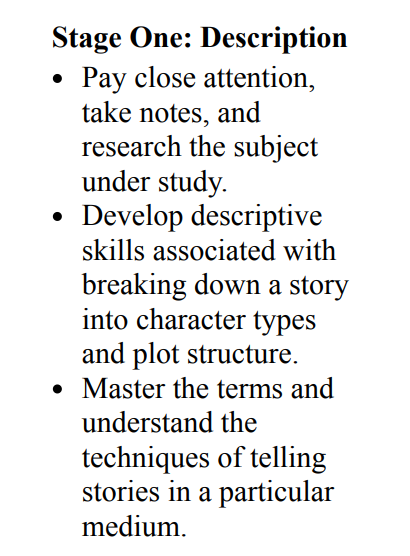
Stage 1: Description
Examples of Description
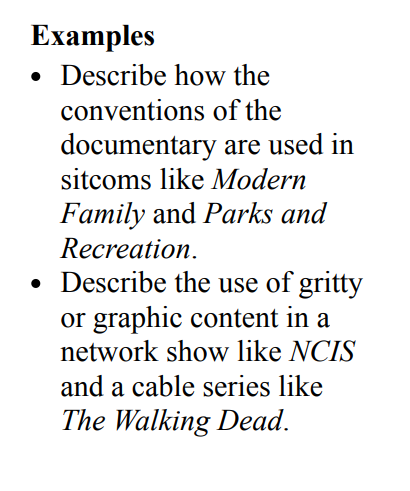
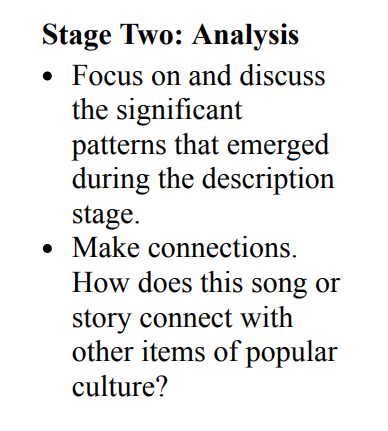
Stage 2: Analysis
Examples of Analysis
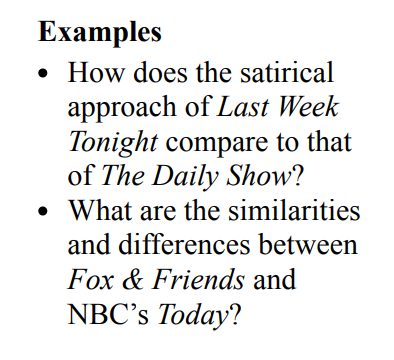
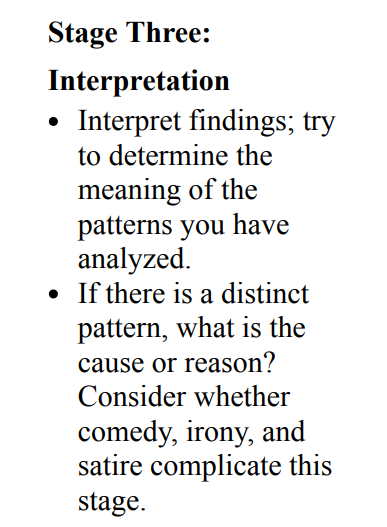
Stage 3: Interpretation
Examples of Interpretation
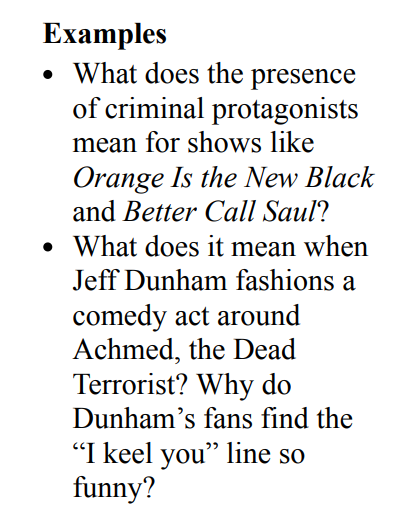
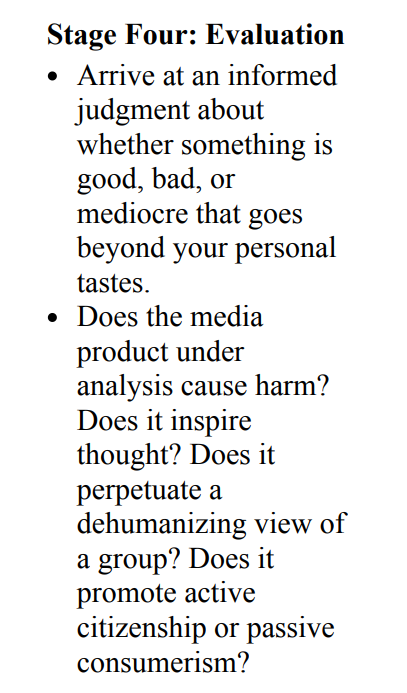
Stage 4: Evaluation
Examples of Evaluation
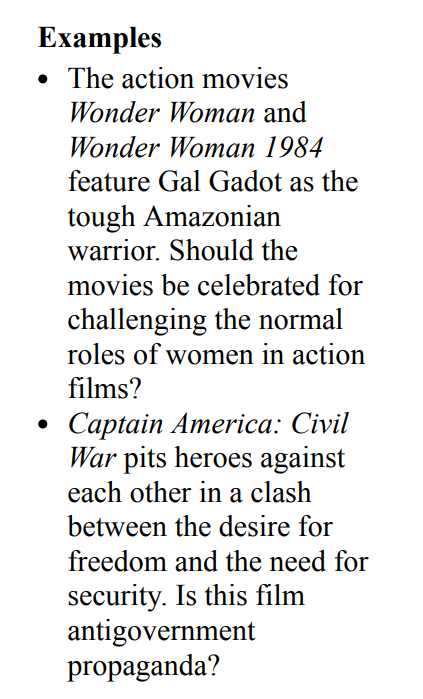
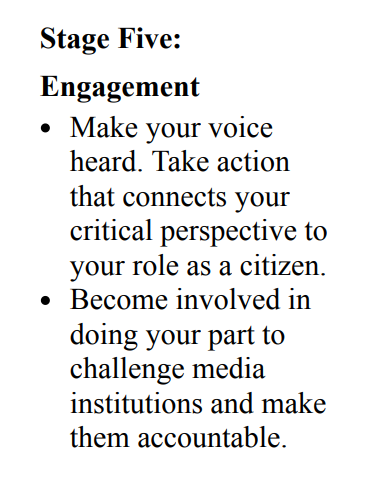
Stage 5: Engagement
Examples of Engagement
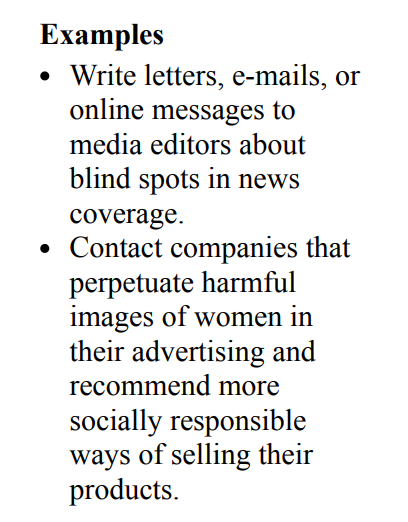
mass media
the cultural industries — channels of communications — that produce songs, novels, news, movies, online services, and other cultural products and distribute them to a large number of people
mass communication
the process of designing and delivering cultural messages and stories to diverse audiences through media channels as old as the book and as new as the internet
digital turn
the shift in media use and consumption resulting from the emergence of the internet as a mass medium
media convergence (in technology)
the merging of content across different channels (ex. magazines available in print or online)
media convergence (in business)
when companies consolidate various media holdings under one umbrella
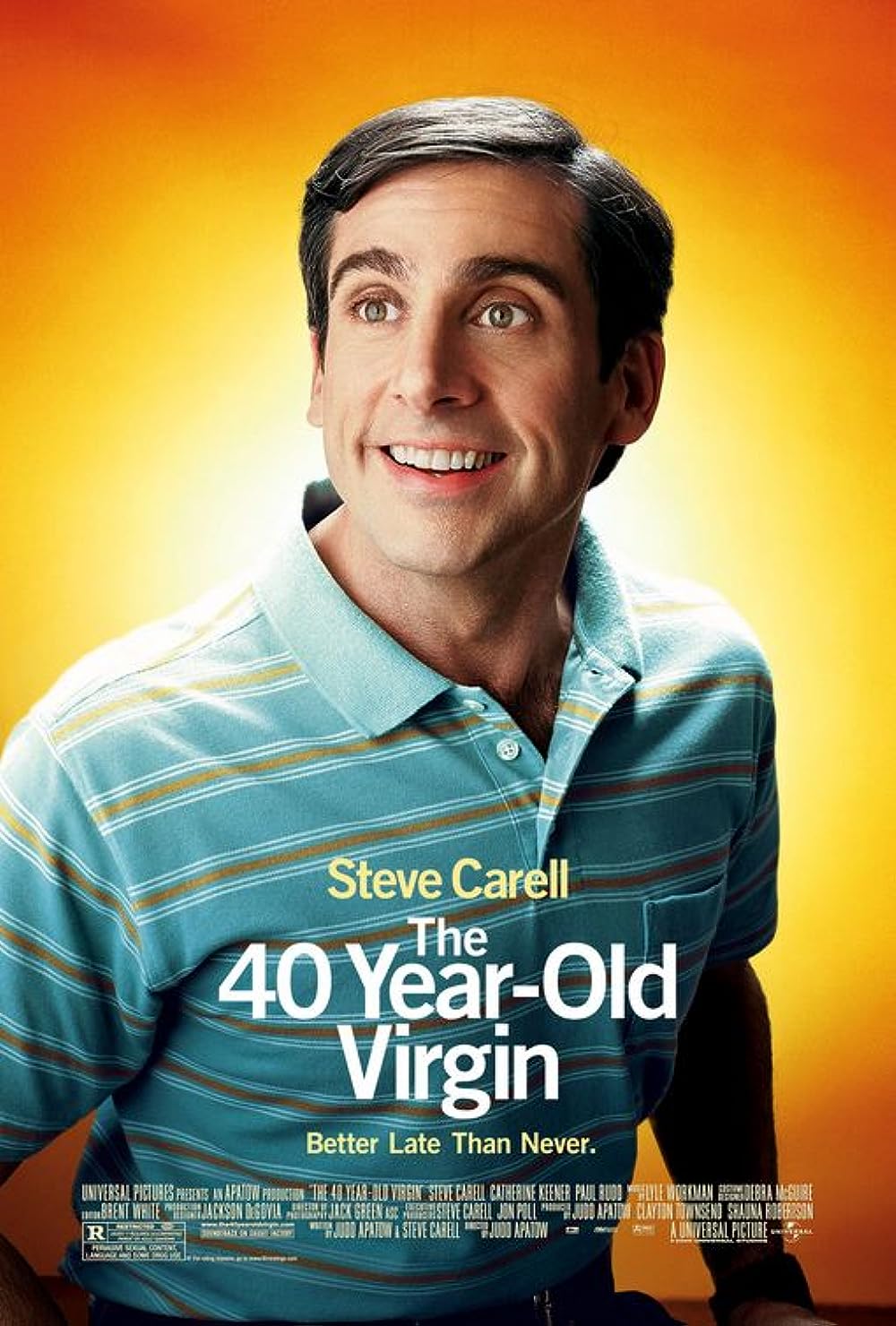
FOMO
fear of missing out
the cultural model
recognizes individuals bring diverse meanings to messages, given factors such as gender/age/education/ethnicity/occupation. in this more complex model of mass communication, audiences affirm, interpret, refashion, or reject messages/stories which flow through various media channels
skyscraper model
culture as a hierarchy -- high culture, low culture
map model
culture as a process -- all is connected yet diverse
modern era
period from the Industrial Revolution to the 20th Century. characterized by efficiency, individualism, rational order, and rejection of tradition
progressive era
period from 1890s-1920s that inspired Americans and mass media to break tradition and embrace change
postmodern era
period from the 60s to present. characterized by populism, questioning authority, embracing technology
populism
a political idea which appeals to the ordinary people by setting up a conflict between "the people" and "the elite"
5 stage critical process of media literacy
employs the techniques of description, analysis, interpretation, evaluation, and engagement
description
developing a working knowledge of the medium
analysis
looking for patterns and making connections
interpretation
ascribing cultural meaning to those patterns
evaluation
making a critically informed judgment
engagement
sharing our conclusions to benefit the larger world
phallic “man card”
symbolic licensure of masculine identity (ex. owning a gun)
illuminated manuscripts
books from the middle ages which featured decorative, colorful designs and illustrations on each page
paperback books
books made with less expensive paper covers, introduced in USA in mid-1800s
dime novels (pulp fiction)
cheaply produced, low price novels popular in USA from 1860s
publishing houses
companies that identified and produced the works of respected writers
synergy
the promotion and sale of a product throughout the various subsidiaries of a media conglomerate
trade books
the most visible book industry segment, ft. hardbound and paperback books aimed at general readers
importance of TX & CA in the textbook business
texas & california have statewide adoption policies governing which texts can be used
professional books
technical books which target various occupational groups, and are not intended for the general consumer market
e-book
digital book read on electronic device
the handmaid’s tale
top selling e-book of 2017
self publishing
once considered a vain enterprise, equated with amateurism and work unworthy of expenses and resources of big publishing houses
audio books
voice recordings of books, read by actors or authors. assists the disabled, also used on commutes or exercising
university press
segment of book industry which publishes scholarly books in specialized areas
acquisitions editors
editors who seek out and sign authors to contracts
how TV&Film assists books
when a book is adopted as a movie or show, book sales soar
conglomerates
concentration of ownership of many media companies, often on a global scale
partisan press
early dominant style of american journalism — distinguished by opinion newspapers which argued the agenda or plan of a particular party
associated press wire service
first newspaper to relay news stories around country & world, originally via telegraph